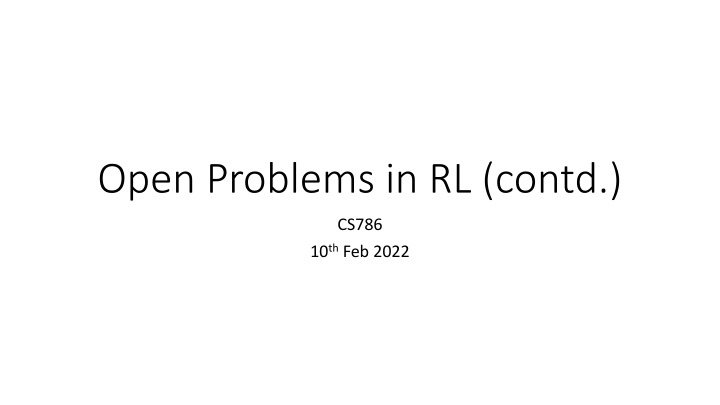
Cutting-Edge Developments in Reinforcement Learning - CS786 Insights
Explore the latest advancements in Reinforcement Learning (RL) methodologies, including value function approximation, non-linear approximations, and the integration of neural networks to enhance Q-value estimations. Discover how RL techniques are evolving to tackle complex problems efficiently.
Download Presentation

Please find below an Image/Link to download the presentation.
The content on the website is provided AS IS for your information and personal use only. It may not be sold, licensed, or shared on other websites without obtaining consent from the author. If you encounter any issues during the download, it is possible that the publisher has removed the file from their server.
You are allowed to download the files provided on this website for personal or commercial use, subject to the condition that they are used lawfully. All files are the property of their respective owners.
The content on the website is provided AS IS for your information and personal use only. It may not be sold, licensed, or shared on other websites without obtaining consent from the author.
E N D
Presentation Transcript
Open Problems in RL (contd.) CS786 10thFeb 2022
Value function approximation RL methods have traditionally approximated the state value function using linear basis functions w is a k valued parameter vector, where k is the number of features that are part of the function Implicit assumption: all features contribute independently to evaluation
Function approximation in Q-learning Approximate the Q table with linear basis functions Update the weights Where is the TD term
Non-linear approximations Universal approximation theorem a neural network with even one hidden layer can approximately represent any continuous-valued function Neural nets were always attractive for their representation generality But were hard to train That changed with the GPU revolution ten years ago
The big idea Approximate Q values using non-linear function approximation = ( , ) ( , ) ( , , ) Q s a Q s a f s a Where are the parameters of the neural network and f(x) is the output of the network for input x Combines both association and reinforcement principles Association buys us state inference Reinforcement buys as action policy learning https://www.nature.com/articles/nature14236
Conv nets basics Image patch Filter Convolution https://ujjwalkarn.me/2016/08/11/intuitive-explanation-convnets/
The Atari test bench A very popular RL test bench Limited space of actions Non-stop reward feedback Free to use Earlier methods used features handcrafted for each game
Schematic illustration of the convolutional neural network. V Mnih et al. Nature 518, 529-533 (2015) doi:10.1038/nature14236
Deep Q network Basic Q learning algorithm augmented a bunch of different ways Use of experience replay Use of batch learning Use of non-linear function approximation
AlphaZero Figure 1: Training AlphaZero for 700,000 steps. Elo ratings were computed from evaluation games between different players when given one second per move. a Performance of AlphaZero in chess, compared to 2016 TCEC world-champion program Stockfish. b Performance of AlphaZero in shogi, compared to 2017 CSA world-champion program Elmo. c Performance of AlphaZero in Go, compared to AlphaGo Lee and AlphaGo Zero (20 block / 3 day) (29).
Secret ingredient Some algorithmic innovations MCTS Mostly, just lots and lots of computation 5000 TPUs to generate game-play 64 TPUs to train the DQN This work closes a long chapter in game-based AI research And brings research in RL to a dead end! https://www.quora.com/Is-reinforcement-learning-a-dead-end
Summary Deep reinforcement learning is the cognitive architecture of the moment Perhaps of the future also Beautifully combines the cognitive concepts of association and reinforcement Excellent generalizability across toy domains Limitations exist: timing, higher-order structure, computational complexity etc.
